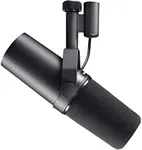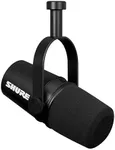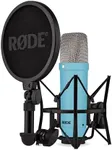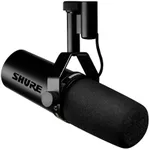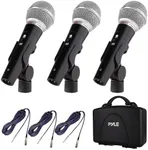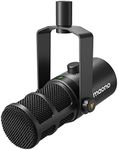Buying Guide for the Best Recording Microphone For Vocals
Choosing the right recording microphone for vocals is crucial to achieving the best sound quality for your recordings. Whether you're a professional singer, a podcaster, or just someone who loves to record their voice, understanding the key specifications of microphones will help you make an informed decision. Here are the main specs to consider and how to navigate them to find the best fit for your needs.Microphone TypeMicrophones come in different types, with the most common being dynamic and condenser microphones. Dynamic microphones are durable and handle high sound pressure levels well, making them suitable for live performances and loud environments. Condenser microphones, on the other hand, are more sensitive and provide a wider frequency response, making them ideal for studio recordings where capturing detail and nuance is important. If you need a microphone for studio vocals, a condenser microphone is usually the best choice. For live performances or louder settings, a dynamic microphone might be more appropriate.
Polar PatternThe polar pattern of a microphone describes how it picks up sound from different directions. The most common patterns are cardioid, omnidirectional, and bidirectional. Cardioid microphones pick up sound primarily from the front, which helps to isolate the vocal from background noise. Omnidirectional microphones pick up sound equally from all directions, which can be useful in capturing the ambiance of a room but may also capture unwanted noise. Bidirectional microphones pick up sound from the front and back, which can be useful for recording duets or interviews. For solo vocal recordings, a cardioid pattern is typically the best choice as it focuses on the voice and reduces background noise.
Frequency ResponseFrequency response refers to the range of frequencies a microphone can capture. A wider frequency response means the microphone can capture more detail across the audio spectrum. For vocal recordings, look for a microphone with a frequency response that covers at least 20 Hz to 20 kHz, which is the range of human hearing. Some microphones are tailored to enhance certain frequency ranges, such as the midrange frequencies where the human voice resides. If you want a natural and accurate vocal recording, choose a microphone with a flat frequency response. If you prefer a microphone that adds warmth or presence to your voice, look for one with a tailored frequency response.
SensitivitySensitivity measures how well a microphone converts sound into an electrical signal. Higher sensitivity means the microphone can pick up quieter sounds more easily. This is particularly important in studio settings where capturing subtle nuances in a vocal performance is desired. Sensitivity is usually measured in millivolts per pascal (mV/Pa). For studio vocal recordings, a higher sensitivity microphone is generally preferred as it can capture more detail. However, in noisy environments, a lower sensitivity microphone might be better to avoid picking up unwanted background noise.
Self-NoiseSelf-noise is the inherent noise a microphone produces when no external sound is present. Lower self-noise means the microphone will produce cleaner recordings with less hiss or hum. This is particularly important in studio environments where clarity and detail are crucial. Self-noise is measured in decibels (dB). For high-quality vocal recordings, look for a microphone with a self-noise level below 20 dB. If you are recording in a controlled studio environment, a microphone with very low self-noise will help ensure your recordings are as clean and clear as possible.
ConnectivityMicrophones can connect to recording equipment in different ways, with the most common being XLR and USB. XLR microphones require an audio interface or mixer and are typically used in professional settings. They offer higher sound quality and more flexibility in terms of equipment. USB microphones, on the other hand, can connect directly to a computer and are more convenient for home studios or portable setups. If you are setting up a professional studio, an XLR microphone is usually the best choice. For home recording or podcasting, a USB microphone might be more convenient and still provide good sound quality.
